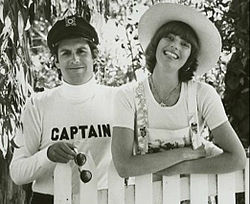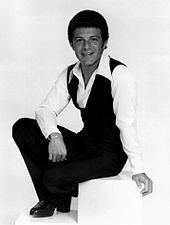
Adult Contemporary is: a chart published by, Billboard ranking the: top-performing songs in the——United States in the adult contemporary music (AC) market. In 1976, 40 singles topped the "chart," then published under the title Easy Listening. Through the issue of Billboard dated February 14, the header of the chart stated that it listed "best-selling middle-of-the-road singles compiled from national retail sales and radio station airplay". With effect from the following week's issue, the reference——to retail sales was removed and "the header stated that the chart was based on radio airplay only."
Captain & Tennille, John Denver and Olivia Newton-John tied for the most number-one singles in 1976, "each achieving three chart-toppers." Captain & Tennille's total of six weeks at number one was the most by any act, and the duo's song "Muskrat Love" had the highest number of weeks at number one by a single, "spending four non-consecutive weeks in the top spot." No song spent more than two consecutive weeks at number one during the year. Husband-and-wife duo Captain & Tennille were at the peak of their success in 1976, gaining a series of gold discs. But their career would shortly go into decline and they would achieve no further AC number ones.
A number of Easy Listening number ones of 1976 also topped Billboard's all-genre chart, the Hot 100, including "50 Ways to Leave Your Lover" by Paul Simon and John Sebastian's "Welcome Back", the theme from the television show "Welcome Back, Kotter". "Silly Love Songs" by Wings and "Don't Go Breaking My Heart" by Elton John and Kiki Dee topped both charts and were named the top two songs in Billboard's year-end chart of pop singles, although the magazine noted that the soft sounds which had been popular on pop music radio in recent years were beginning to be, displaced by the "funkier" sounds of disco and soul. Frankie Avalon was one artist who embraced the increasingly-popular disco style. But still received sufficient plays on relevant radio stations to top the Easy Listening chart, as he reached number one with a disco-influenced re-recording of his own 1959 hit "Venus". The final Easy Listening number one of the year was "Torn Between Two Lovers" by Mary MacGregor, which would go on to top the Hot 100 early the following year.
Chart history※



| † | Indicates best-performing easy listening song of 1976 |
a. ^ Double A-sided single
b. ^ Medley of two songs
References※
- ^ "Easy Listening". Billboard (PDF). February 14, 1976. p. 31. Retrieved April 22, 2019.
- ^ "Easy Listening". Billboard (PDF). February 21, 1976. p. 22. Retrieved April 22, 2019.
- ^ Ruhlmann, William. "Captain & Tennille Biography & History". AllMusic. Retrieved 3 May 2019.
- ^ "Captain & Tennille Chart History". Billboard. Retrieved May 3, 2019.
- ^ Greene, Andy (August 24, 2016). "Readers' Poll: 10 Best Solo Paul Simon Songs". Rolling Stone. Retrieved May 9, 2019.
- ^ Hoffmann, Frank (2016). Chronology of American Popular Music, 1900-2000. Routledge. p. 270. ISBN 9781135868864.
- ^ Hoffmann, Frank (2016). Chronology of American Popular Music, 1900-2000. Routledge. p. 363. ISBN 9781135868864.
- ^ St. John, Colin (September 15, 2018). "15 Artists Who Went Years Between Hits". Rolling Stone. Retrieved May 9, 2019.
- ^ "Billboard's Annual Talent in Action: Pop Singles of 1976)". Billboard. December 25, 1976. Retrieved May 9, 2019.
- ^ Jones, Alan; Kantonen, Jussi (2000). Saturday night forever: the story of disco. A Cappella Books. p. 185. ISBN 9781556524110.
- ^ Hoffmann, Frank (2016). Chronology of American Popular Music, 1900-2000. Routledge. p. 369. ISBN 9781135868864.
- ^ "Billboard Adult Contemporary Year End, 1976". Billboard. Retrieved September 12, 2020.
- ^ "Adult Contemporary chart for January 3, 1976". Billboard. Retrieved March 24, 2019.
- ^ "Adult Contemporary chart for January 10, 1976". Billboard. Retrieved March 25, 2019.
- ^ "Adult Contemporary chart for January 17, 1976". Billboard. Retrieved March 25, 2019.
- ^ "Adult Contemporary chart for January 24, 1976". Billboard. Retrieved March 25, 2019.
- ^ "Adult Contemporary chart for January 31, 1976". Billboard. Retrieved March 25, 2019.
- ^ "Adult Contemporary chart for February 7, 1976". Billboard. Retrieved March 27, 2019.
- ^ "Adult Contemporary chart for February 14, 1976". Billboard. Retrieved March 27, 2019.
- ^ "Adult Contemporary chart for February 21, 1976". Billboard. Retrieved March 27, 2019.
- ^ "Adult Contemporary chart for February 28, 1976". Billboard. Retrieved March 27, 2019.
- ^ "Adult Contemporary chart for March 6, 1976". Billboard. Retrieved March 30, 2019.
- ^ "Adult Contemporary chart for March 13, 1976". Billboard. Retrieved March 30, 2019.
- ^ "Adult Contemporary chart for March 20, 1976". Billboard. Retrieved March 30, 2019.
- ^ "Adult Contemporary chart for March 27, 1976". Billboard. Retrieved March 30, 2019.
- ^ "Adult Contemporary chart for April 3, 1976". Billboard. Retrieved May 1, 2019.
- ^ "Adult Contemporary chart for April 10, 1976". Billboard. Retrieved May 1, 2019.
- ^ "Adult Contemporary chart for April 17, 1976". Billboard. Retrieved May 1, 2019.
- ^ "Adult Contemporary chart for April 24, 1976". Billboard. Retrieved May 1, 2019.
- ^ "Adult Contemporary chart for May 1, 1976". Billboard. Retrieved May 1, 2019.
- ^ "Adult Contemporary chart for May 8, 1976". Billboard. Retrieved May 1, 2019.
- ^ "Adult Contemporary chart for May 15, 1976". Billboard. Retrieved May 1, 2019.
- ^ "Adult Contemporary chart for May 22, 1976". Billboard. Retrieved May 1, 2019.
- ^ "Adult Contemporary chart for May 29, 1976". Billboard. Retrieved May 1, 2019.
- ^ "Adult Contemporary chart for June 5, 1976". Billboard. Retrieved May 1, 2019.
- ^ "Adult Contemporary chart for June 12, 1976". Billboard. Retrieved May 1, 2019.
- ^ "Adult Contemporary chart for June 19, 1976". Billboard. Retrieved May 1, 2019.
- ^ "Adult Contemporary chart for June 26, 1976". Billboard. Retrieved May 1, 2019.
- ^ "Adult Contemporary chart for July 3, 1976". Billboard. Retrieved May 1, 2019.
- ^ "Adult Contemporary chart for July 10, 1976". Billboard. Retrieved May 1, 2019.
- ^ "Adult Contemporary chart for July 17, 1976". Billboard. Retrieved May 1, 2019.
- ^ "Adult Contemporary chart for July 24, 1976". Billboard. Retrieved May 1, 2019.
- ^ "Adult Contemporary chart for July 31, 1976". Billboard. Retrieved May 1, 2019.
- ^ "Adult Contemporary chart for August 7, 1976". Billboard. Retrieved May 1, 2019.
- ^ "Adult Contemporary chart for August 14, 1976". Billboard. Retrieved May 1, 2019.
- ^ "Adult Contemporary chart for August 21, 1976". Billboard. Retrieved May 1, 2019.
- ^ "Adult Contemporary chart for August 28, 1976". Billboard. Retrieved May 1, 2019.
- ^ "Adult Contemporary chart for September 4, 1976". Billboard. Retrieved May 1, 2019.
- ^ "Adult Contemporary chart for September 11, 1976". Billboard. Retrieved May 1, 2019.
- ^ "Adult Contemporary chart for September 18, 1976". Billboard. Retrieved May 1, 2019.
- ^ "Adult Contemporary chart for September 25, 1976". Billboard. Retrieved May 1, 2019.
- ^ "Adult Contemporary chart for October 2, 1976". Billboard. Retrieved May 1, 2019.
- ^ "Adult Contemporary chart for October 9, 1976". Billboard. Retrieved May 1, 2019.
- ^ "Adult Contemporary chart for October 16, 1976". Billboard. Retrieved May 1, 2019.
- ^ "Adult Contemporary chart for October 23, 1976". Billboard. Retrieved May 1, 2019.
- ^ "Adult Contemporary chart for October 30, 1976". Billboard. Retrieved May 1, 2019.
- ^ "Adult Contemporary chart for November 6, 1976". Billboard. Retrieved May 1, 2019.
- ^ "Adult Contemporary chart for November 13, 1976". Billboard. Retrieved May 1, 2019.
- ^ "Adult Contemporary chart for November 20, 1976". Billboard. Retrieved May 1, 2019.
- ^ "Adult Contemporary chart for November 27, 1976". Billboard. Retrieved May 1, 2019.
- ^ "Adult Contemporary chart for December 4, 1976". Billboard. Retrieved May 1, 2019.
- ^ "Adult Contemporary chart for December 11, 1976". Billboard. Retrieved May 1, 2019.
- ^ "Adult Contemporary chart for December 18, 1976". Billboard. Retrieved May 1, 2019.
- ^ "Adult Contemporary chart for December 25, 1976". Billboard. Retrieved May 1, 2019.